
Thenral, earlier known as Brodie Castle, is a house in Chennai, India. Named after civil servant James Brodie (1769-1801) who constructed the house in 1796, it currently houses the School of Carnatic music. [1] [2]

Thenral, earlier known as Brodie Castle, is a house in Chennai, India. Named after civil servant James Brodie (1769-1801) who constructed the house in 1796, it currently houses the School of Carnatic music. [1] [2]
Brodie Castle was constructed by British East India Company servant and businessman, James Brodie on eleven acres of land gifted to him by the Government in Quibble Island in the town of Adyar, then located outside the limits of Madras city. [3] Brodie inhabited the house for a short period but later, due to his declining fortunes, rented the house to tenants, the first of whom was Sir Thomas Strange, the first Chief Justice of the Supreme Court of Madras. [3]
Following Brodie's death in 1801 in a boating accident, the family sold the property which was purchased by the Arbuthnot Family who resided in it for a while. [1] Brodie was heir to the chief of clan Brodie, whose seat was Brodie Castle in Morayshire, Scotland. Brodie Castle is now owned by the National Trust for Scotland. [4]
Coordinates: 13°00′57″N80°15′46″E / 13.015855°N 80.262857°E
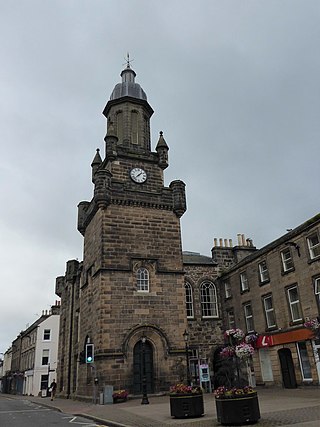
Forres is a town and former royal burgh in the north of Scotland on the Moray coast, approximately 25 miles (40 km) northeast of Inverness and 12 miles (19 km) west of Elgin. Forres has been a winner of the Scotland in Bloom award on several occasions. There are many geographical and historical attractions nearby such as the River Findhorn, and there are also classical, historical artifacts and monuments within the town itself, such as Forres Tolbooth and Nelson's Tower. Brodie Castle, the home of the Brodie Clan, lies to the west of the town, close to the A96.
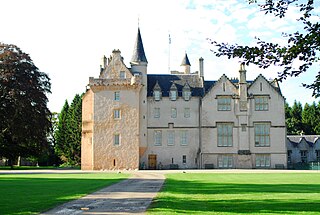
Brodie Castle is a well-preserved Z plan castle located about 3+1⁄2 miles west of Forres, in Moray, Scotland. The castle is a Category A listed building and the grounds are included in the Inventory of Gardens and Designed Landscapes in Scotland.

Powis Castle is a British medieval castle, fortress and grand country house near Welshpool, in Powys. The seat of the Herbert family, Earls of Powis, the castle is known for its formal gardens and for its interiors, the former having been described as "the most important", and the latter "the most magnificent", in Wales. The castle and garden are under the care of the National Trust. Powis Castle is a Grade I listed building, while its gardens have their own Grade I listing on the Cadw/ICOMOS Register of Parks and Gardens of Special Historic Interest in Wales.
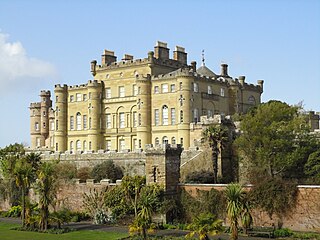
Culzean Castle is a castle overlooking the Firth of Clyde, near Maybole, Carrick, in South Ayrshire, on the west coast of Scotland. It is the former home of the Marquess of Ailsa, the chief of Clan Kennedy, but is now owned by the National Trust for Scotland. The clifftop castle lies within the Culzean Castle Country Park and is opened to the public. From 1972 until 2015, an illustration of the castle was featured on the reverse side of five pound notes issued by the Royal Bank of Scotland.

Clan Gordon is a Highland Scottish clan, historically one of the most powerful Scottish clans. The Gordon lands once spanned a large territory across the Highlands. Presently, Gordon is seated at Aboyne Castle, Aberdeenshire. The Chief of the clan is the Earl of Huntly, later the Marquess of Huntly.

Castle Coole is a townland and a late-18th-century neo-classical mansion situated in Enniskillen, County Fermanagh, Northern Ireland. Set in a 1,200-acre (490 ha) wooded estate, it is one of three properties owned and managed by the National Trust in County Fermanagh, the others being Florence Court and the Crom Estate.

Clan Brodie is a Scottish clan whose origins are uncertain. The first known Brodie chiefs were the Thanes of Brodie and Dyke in Morayshire. The Brodies were present in several clan conflicts, and during the civil war were ardent covenanters. They resisted involvement in the Jacobite uprisings, and the chief's family later prospered under the British Empire in colonial India.
Brigadier-General John Carnac was a British officer who served three times as Commander-in-Chief of India. The son of Capt. Peter Carnac (1665–1756), and Andrienne, née Lelonte, he was baptised in London.
Sir Robert Townsend Farquhar, 1st Baronet was an influential British merchant of the early nineteenth century who served as a colonial governor and Member of Parliament. During his lengthy service for both the East India Company and the British government, Farquhar gained a reputation as an efficient and ambitious administrator and he notably served as Lieutenant-Governor of Prince of Wales Island from January 1804 to 1805 and as governor of Île de Bourbon, now known as Réunion from 1810 to 1811.

Quibble Island is a river island in the city of Chennai, Tamil Nadu, India. Prior to British colonization, it was not an island but a network of inter-tidal channels. It is formed by the encirclement of the Adyar River and one of its tributaries. It is situated between the neighbourhoods of Mylapore and Adyar. It abuts the southern stretch of the Marina Beach. During the British rule, a European cemetery was located here. It also houses the grave of famous actor J. P. Chandrababu.

General John Munro of the H.E.I.C.S was a Scottish soldier and administrator who served as Resident and Diwan of the States of Travancore and Cochin between 1810 and 1819.

Cumbernauld Castle was the predecessor of Cumbernauld House in the Park in Cumbernauld. The Motte of the earliest castle survives, and stones of the second castle are incorporated in the present house.
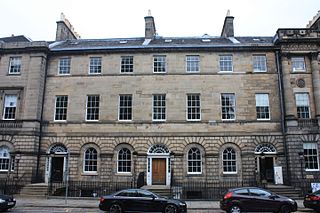
The Georgian House is an 18th-century townhouse situated at No. 7 Charlotte Square in the heart of the historic New Town of the city of Edinburgh, Scotland. It has been restored and furnished by the National Trust for Scotland, and is operated as a popular tourist attraction, with over 40,000 visitors annually.
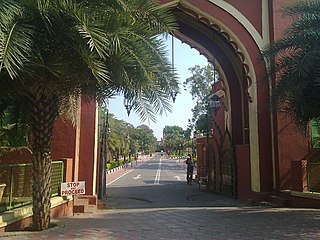
Amir Mahal is the official residence of the titular Nawab of Arcot and his family. Situated in Royapettah, a neighbourhood of Chennai, India, it was constructed in Indo-Saracenic style in 1798, the Amir Mahal has been the residence of the family since 1876. The Prince of Arcot, Nawab Mohammed Abdul Ali, lives in the palace with his family.

Ekambareswarar Temple, Chennai is a Hindu temple situated in the neighbourhood of Parry's corner, Chennai, India dedicated to Lord Shiva. It was constructed by Alanganatha Pillai, chief merchant of the Madras factory of the British East India Company.

The Senate House is the administrative centre of the University of Madras in Chennai, India. It is situated in Wallajah Road, along Marina Beach. Constructed by Robert Chisholm between 1874 and 1879, the Senate building is considered to be one of the best and oldest examples of Indo-Saracenic architecture in India.
Basil Cochrane was a Scottish civil servant, businessman, inventor, and wealthy nabob of early-19th-century England.
The Royal Madras Yacht Club (RMYC) is a yacht club in Chennai, India. The RMYC was founded by Sir Francis Spring in 1911. It was the first sailing club in southern India, and was originally based in what was called the Timber Pond area of Madras Harbour. Soon after its founding the club was granted royal patronage by George V, and it became one of the most prestigious sporting and social clubs in British India. Today the club is located at Springhaven Wharf, named after its founder.

Alexander Brodie, 19th of that Ilk was a Scottish clan chief and politician from Moray. He sat in the House of Commons of Great Britain for 34 years from 1720 to 1754, as a government supporter. For 27 years he was Lord Lyon King of Arms, the most junior of the Scottish Great Officers of State, responsible for regulating the heraldry of Scotland.
Major-General Norman MacLeod of MacLeod FRS FRSE was a Scottish soldier and politician, who served as MP for Inverness-shire 1790 to 1796, a seat previously held by his grandfather, Norman MacLeod. Thomas Pennant called him “unusually intelligent”. As an MP, he was one of the early campaigners (1796) to abolish the slave trade. He was the 23rd Chief of Clan MacLeod.